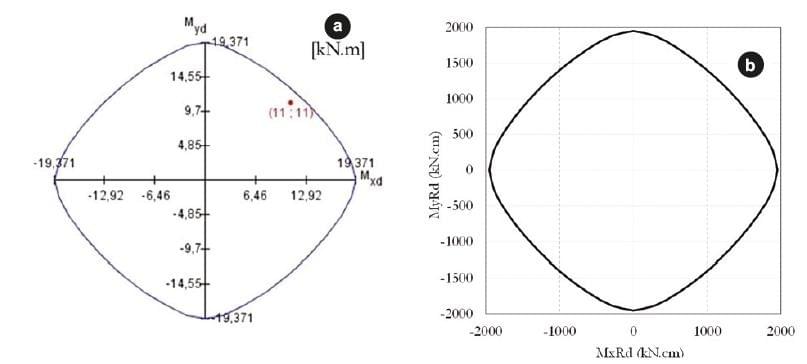
Concrete Column Interaction Diagrams Software Development
This is contrary to many other programs in which models are based on phenomenological behavior in common situations, which cannot be extrapolated to special conditions such as failure of composite structures with specific loading conditions or loading history.. In addition to the reinforced concrete structures specific technical data and specifications below, see also the general functionality information (to the right of this page). 1
Failure analysis of reinforced concrete was a leading subject for research in the late 80s and 90s in Europe, the US and Japan.. In the second half of the 90s, with the support of Dutch Ministry of Public Works, these concepts were further developed into models that could be used in the frame work of a 3-dimensional general purpose program for application on practical structures.. Our range of brochures are also available for download Or, if you have a specific question about DIANA that would like to ask, please use the webform.. DIANA was used as the numerical platform for development and validation of concepts, as well as for the numerical models for cracking of concrete, by a consortium of research organisations.. Download design of footing software for free Photo & Graphics tools downloads - Spread Footing Design by Digital Canal Corporation and many more programs are available for instant and free download. Click
DIANA can perform integral failure analysis of structures, taking into account construction phases and loading history, including heat loadings, stresses from the concrete hardening, soil-structure interaction, dynamic loadings and changing material behaviour with time.. Modelling and analysis featuresEmbedded reinforcements with grids and bars defined independently from finite element meshBond-slip reinforcementPre and post tensioningReinforced concrete concept applicable in all element types such as solids, plane stress, plane strain, axi-symmetric, shell and plate elements, beam elements and interface elements.. This formed the basis of analysis capabilities for failure of reinforced concrete structures upon which DIANA was defined.. Construction-staged analysis for accurate description of loading historyStaggered and fully coupled heat-stress analysis for thermal effects on loading of structureAmbient influence on material behaviourYoung hardening concrete behavior also with coolingDedicated post-processing of crack patternsMaterial modelsDiscrete cracking with interface elementsMulti-directional Fixed cracking with strain decomposition, with possibility to combine with plastic failure for crushing and temperature and creep effectsTotal-strain crack models with fixed and rotating cracks for tensile and compressive failure, with possibility to combine with temperature and creep effectsCreep and shrinkage models according to different international design codesElasto-plastic models such as Mohr-Coulomb, Drucker-Prager, RankineModified Maekawa-Fukuura model for cyclic loading conditionsVon-Mises plasticity with hardening for steel reinforcement, and several typical models for cyclic loadingUser-supplied materialsModified two-surface model for cyclic behaviour of steelMenegotto-Pinto, Monti Nuti, and Dodd Restreppo plasticity models for reinforcementsModelling and analysis featuresFull 3D modeling capabilities with solid elements, shells and beamsComposed elements which allow to calculating cross-section forces and bending moments in references lines and reference places from compositions of solid and shell elementsAutomatic coupling of different element typesReference to material definitions of international design codesMobile loading and influence field analysisEasy definition and handling of load combinations and scanning over results from different load casesDesign checks of reinforcement gridsMaterial models. HERE
For the accurate analysis of damage development, and failure of reinforced concrete structures, the different material characteristics of steel and concrete need to be considered precisely.. Recently, DIANA has been extended with design checking capabilities for reinforcement grids in plate structures in full 3D models in accordance with modern international design codes.. Mathematical formulations for cracking and crushing of concrete were developed and validated in experimental tests.. DIANAs reinforced concrete models are based on the exact geometry definition of reinforcements and concrete, the explicit description of material failure of the steel reinforcements, the concrete and the bond-slip connection between both.. Also, added is a sequential linear analysis module for easy assessment of Ultimate Limit State, and Serviceability Limit State assessment by a series of linear analysis stiffness in overloaded integration-points, which are reduced in the maximum strain direction in subsequent steps. e828bfe731 https://stoic-banach-110aa2.netlify.app/Logo-Quiz-Download-For-Mac
Thus, in DIANA, design of Full 3D structures, inclusive easy assessment of ULS/SLS and fully integrated failure analysis of reinforced structures can all be done in the same program.. In addition, new features have been added at a material level to consider the heterogeneity of concrete, as well as introducing fiber materials in order to simulate fiber reinforced material models.. In the last decade, the practical application of DIANA, in terms of user-friendliness and performance have been further developed. 5